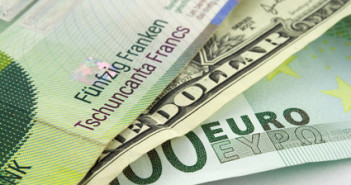Not unusually for the second half of September, the tone in currency and asset markets was decidedly cautious yesterday. The euro, was troubled by a weak Ifo, compounded by Spain’s continuing hesitation to apply for financial aid, and concerns over renewed fiscal slippage in Greece. The single currency remains above the key long-term moving averages, at least for now, but a test of the 200d at 1.2825 in the near term is likely.
Sterling continues to surprise, at least in relative terms, with cable still holding up around the 1.62 area. Month and quarter-end flows are expected to benefit the pound, with traders apparently positioning for these anticipated flows over recent days. Also, traders have been forced to cover some of the shorts built up in sterling over the course of the month.
Guest post by Forex Broker FxPro
Against this defensive backdrop, the dollar has continued to head higher. Of interest is that the greenback has been consistently bid since the Fed announced their latest injection of QE. The higher dollar and renewed risk aversion also weighed on commodities, with Brent crude down USD 2 at USD 110.
Commentary
The euro on the back foot. The single currency remained on the back foot yesterday as it flirted with the 1.29 level, largely owing to the negative reading on the latest German Ifo number, the main business confidence survey in the eurozone’s largest economy. Looking back over the past 10 years, the latest reading is consistent with growth of around 0.5% in annual terms. With the German economy having grown a modest 0.5% and 0.3% QoQ in the previous two quarters, it’s not that much of a stretch to see further negative readings into the end of the year. That said, the German central bank was sounding cautiously optimistic yesterday morning, stating: “The German economy made a very good start to the summer quarterâ€. Even though Germany largely escaped the eye of the storm in both the first credit crisis and the subsequent sovereign crisis in Europe, nevertheless it is finding it hard to escape the latest ill winds blowing through the global economy. It also comes at a time when growth concerns are coming through in China, investors are worrying about the ‘fiscal cliff’ in the US and the UK is grappling with weak economic performance in the face of continued austerity. The common thread is that the previous perceived growth engines of the world that help prop up the global economy in the 2008-10 period (so Germany but also China, Brazil and India) are looking more precarious this time around and less able to provide an offsetting force. These conditions also make for a more difficult backdrop for FX, with the negative downdraft from QE on currencies less strong, not least because the options for carry trades (i.e. borrowing at low rates and investing in higher-yielding currencies) are perhaps less assured than before. The dollar index is now bang on the levels seen ahead of the Fed’s QE announcement. Some of this is down to the extent of the dollar sell-off before the announcement, but it does undermine the belief that QE is going to be strongly dollar-negative.
A heavy tone in the Aussie. Last week’s soft Aussie underbelly continued yesterday, amidst gentle and consistent selling pressure from traders and investors alike. China’s faltering expansion remains a concern, with a PBOC official remarking that signs of a pick-up in activity remain muted. Domestically, the worry down under is that the economy is also vulnerable, with some of the major mining companies voicing anxiety regarding the expensive currency. Indeed, many major Australian miners are shedding jobs and reducing their forward investment plans because of the high currency. Next week the RBA Board meets, and the sense is growing that it might cut rates again. As we have been suggesting, we expect that the Aussie is now in a trading range bounded by 1.06 up top and parity beneath. Under this scenario, anywhere near 1.06 is a good area to sell, while parity is a rewarding place to buy.



